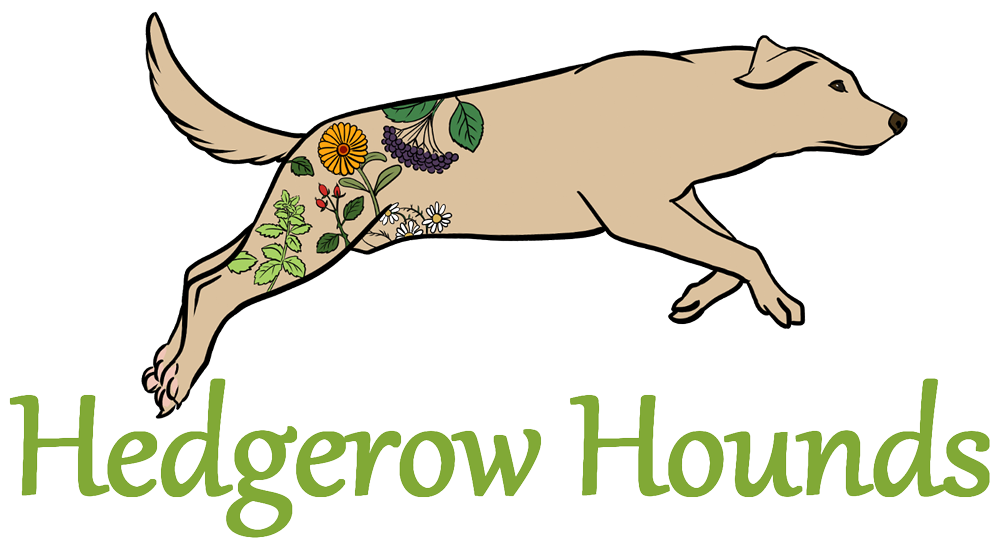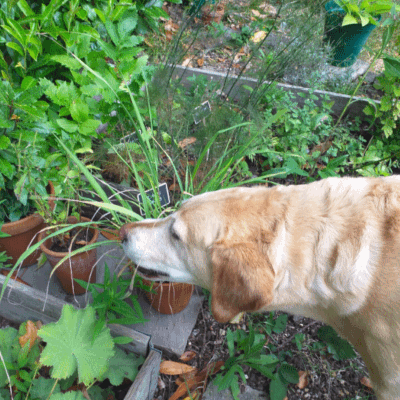Dogs eating grass is something I am asked about on a regular basis and it can cause concern for owners as they presume that their dog must be ill or lacking in nutrients of some kind. So what might our dogs be getting out of eating their daily helping of “Dr Green” and should it be something we discourage?
The most popular grass our dogs seek out is Elymus Repens commonly known as Couch grass or funnily enough Dog Grass!
The new shoots in the spring are tender, moist and sweet with natural occurring sugars but as the grass matures it can become rough with tiny barbs which you can feel if you run your fingers down the middle and outer edges. This may be relevant when the dog chooses a certain patch of grass for a specific purpose. Other herbs selected in the early months are cleavers and dandelion leaves, these are an effective spring tonic for the liver, urinary and lymphatic system, which can become sluggish over the winter months.
Some dogs, particularly those on a dry food diet may be seeking out additional water from the leaves and roots or even the dew that lays on the top of the shoots. I have observed that dogs will rush to nip out the tops of grass first thing in the morning but show very little interest in the same patch in the afternoon.
Fibre:
Vegetables and fresh grass are abundant in a variety of dietary fibres which are needed to keep the gut and the beneficial gut microbes within it functioning effectively. There is now evidence to show how the balance of our gut microbiome impacts on our mental and physical health, this also applies to our dogs. Encouraging a healthy population of good microbes means there is far less space for the bad microbes to take up residence.
I expect most of us have seen our dogs take immense delight in consuming the droppings of animals such as cows and horses which is basically just pre-digested grass which once passed through a herbivore contains digestive enzyme and probiotic qualities.
If you feel your dog is eating too much grass or may need more fibre in their diet then try adding a few steamed vegetables or blitzing raw veg in a blender and adding it to their meals. This can include broccoli, spinach, courgette, kale, parsley, dandelion greens or even some spirulina to see if they reduce their intake. This can often stop the desire to consume large quantities of grass within a few days. A really useful supplement with is rich in chlorophyll and green vegetables is the Greens, Seeds & Superfoods blend which can be found on this link: https://www.hedgerowhounds.co.uk/products/greens-seeds
Nutrients:
Grasses do not offer a large amount of nutrients to our dogs, but they do provide a certain amount of vitamin A, B, iron, fibre and silica as well as astringent properties and chlorophyll which dogs really seem to crave at certain times of the year.
There is a theory that our dogs still have some of the traits of their distant ancestors. Wolves and wild canines would hunt and kill herbivores or possibly scavenge from the carcass and consume some of the contents of the preys stomach which contain partly digested grasses, herbs and other roughage. This provides welcome moisture, fibre and enzymes to help in the process of digesting a heavy, meat rich meal.
When to investigate further:
The majority of dogs will eat grass most days and seem to thoroughly enjoy the experience. They will do this despite having a good balanced diet which includes fibre from vegetables and never have any adverse effects such as vomiting afterwards.
However, there are circumstances where further investigation is necessary. There is no doubt that some dogs will actively seek out certain grasses to induce vomiting. You may notice your dog drooling, licking their lips, swallowing hard and rushing outside to eat grass. This tends to be a rapid, frantic, grabbing at grass rather than the slow, selective grazing usually seen. After vomiting has occurred this may give temporary relief of nausea, reflux or easing of stomach irritation. Most of us would have seen our own dogs or those of others do this and they seem to be totally unaffected afterwards and back to their normal self within minutes.
If your dog is regularly eating large volumes of grass particularly after their meals and then vomiting, there could be an underlying health issue that needs investigating by your vet. Dogs may induce vomiting in order to eat the regurgitated food immediately afterwards as they have an inability to absorb nutrients and need to re-ingest the stomach contents to make it more digestible, this will also require a visit to your vet for further tests.
Eating a large amount of course grass which cannot be digested will cause stomach irritation and add volume and bulk to the stools as well as being passed out the other end almost intact. Dogs can exhibit this behavior if they are carrying a worm burden as it encourages elimination of parasites. To rule out this possibility it is important to carry out a fecal worm count to establish if this is the actual cause.
Where to take additional care:
Often the only access dogs have to grass is from the lawn, footpaths that run alongside arable fields or from eating young shoots of barley or wheat growing in fields. All these areas are very likely to have been treated with chemicals of one form or another. We should avoid using artificial fertilisers or chemical treatments on our lawns as dogs will ingest them and also absorb the chemicals through the skin on their pads. Special care is needed to avoid arable fields at certain times of the year or at the very least keep dogs on a lead if you have no choice but to walk alongside them.
If you want to provide a clean source of fresh grass or greenery then it is easy to grow couch, barley or wheat grass in individual pots for your dog to help themselves as and when they desire. You could also make a small area in the garden where your dog can be free to sniff, explore and have access to grasses and herbs which are pollutant and chemical free.
Grass can be grown in pots for the dogs to pick at if they wish. This pot has Lemon Grass in but Wheat and Barley grass are also easy to grow and well received.


